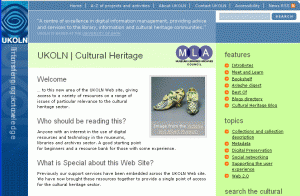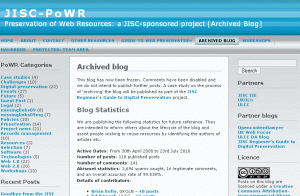
Marieke Guy
I’m Marieke Guy and I’m a research officer at UKOLN. UKOLN is a centre of excellence in digital information management based at the University of Bath. Although we have library roots (we used to be the UK Office for Library and Information Networking) and are now primarily funded by the JISC who provide leadership in the use of ICT to support education and research) we have a lot of connections with the museum world.
UKOLN’s work for the Cultural Heritage Sector
We have an area of the Web site dedicated to the cultural heritage sector. There are briefing documents aimed at supporting use of networked technologies and services in the museums, libraries and archives sectors, the UKOLN cultural heritage blog and information about forthcoming events: workshops and presentations by UKOLN staff.
Digital Preservation
One area of work that may be of of particular interest to many of you working in the museum sector is digital preservation. I know preservation used to mean looking after your Egyptian artefacts but our biggest challenges are often now in the digital world! UKOLN has a long record of working in the traditional digital preservation arena with involvement in projects like CEDARS and the Digital Curation Centre. More recently we have been looking at Web preservation and the challenges it poses through the JISC Preservation of Web Resources project. The end result was a handbook and a more user-friendly Guide on how to preserve Web sites.

We feel that there is a real need for more understanding of the issues surrounding Web preservation. In the current financial climate where cuts are a daily matter it is likely that many Web resources and initiatives will end up being shelved. Preserving both the Web sites and the social networking tools that support them is an increasingly crucial activity.
Preserving blogs
Blogs are a everywhere these days. There so many great museum ones about, like the The V&A series, some of which are ‘closed’ but still viewable (e.g. artist in residence ones). UKOLN staff members now write for a number of blogs and we want to make sure that we practice what we preach when a blogs comes to the end of its life. At this year’s iPres conference (7th International Conference on Preservation of Digital Objects) I will be presenting a paper on ‘Approaches to archiving professional blogs in the cloud’. The paper is available from the University of Bath repository and the slides are available from Slideshare. The paper uses 3 of our blogs (the JISC PoWR blog, the UK Web Focus blog and the Institutional Web Management Workshop 2009 blog – a project blog, a professional blog and an event blog) as case studies and looks at different approaches that can be taken. For example the JISC PoWR blog was recently frozen. Prior to this a record of the status of a project blog was taken and published. A rich copy of the contents of the blog has also been held on a WordPress blog on the UKOLN Intranet which provides a backup managed within the organisation.

The work carried out in understanding appropriate solutions for our archiving of UKOLN blogs hosted in the Cloud has helped us to identify appropriate practices which may help those who make use of blogs provided by third-parties in ensuring they don’t just ‘disappear’. The paper provides a best practice check list which includes planning, clarification of rights, monitoring of technologies used, auditing, understanding of costs and benefits, identification and implementation of archiving strategy, dissemination, learning and organisational audit.
A case study on archiving the JISC PoWR blog has also been written.
Preserving Tweets
Another area of interest is preserving Tweets. There are many reasons why you might want to preserve tweets, for example as a cultural snap-shot, as a measure of impact or to record an event. Numerous museums now have Twitter accounts. A few of my favourites include the Natural History Whale at the Natural History Museum, New York, I am Henry VIII from Hampton Court Palace and the SS Great Britain Trust. We actually had a guest blog post on the Cultural Heritage blog about this particular one (What’s Happening? SS Great Britain Trust and Twitter). Some of you may be aware that in April 2010 Twitter announced that they will be donating the entire archive of public Tweets to the Library of Congress for preservation and research. They see Twitter as a historical record of communication, news reporting, and social trends. Although this is highly significant for museums it doesn’t transfer the responsibility away from individuals and organisations. You will still need to think about preservation of tweets that are of importance to your organisation.
 One option is to use a service like Twapper Keeper which allows users to create an archive of tweets for a hashtag. UKOLN has been project managing a development project at Twapper Keeper and will be presenting a poster on ‘Twitter Archiving Using Twapper Keeper: Technical And Policy Challenges’ at the iPres Conference. Again the paper is held on the University of Bath repository, the poster available from Scribd.
One option is to use a service like Twapper Keeper which allows users to create an archive of tweets for a hashtag. UKOLN has been project managing a development project at Twapper Keeper and will be presenting a poster on ‘Twitter Archiving Using Twapper Keeper: Technical And Policy Challenges’ at the iPres Conference. Again the paper is held on the University of Bath repository, the poster available from Scribd.
Hopefully this post has shown you that UKOLN is involved in some interesting digital preservation work. I myself am currently working on the JISC Beginner’s Guide to Digital Preservation – the creation of a guide that pulls together many of the resources already out there in order to help project managers make informed digital preservation decisions. Digital preservation has been likened to chasing a moving train, one of the reasons I personally find it so interesting! While we at UKOLN continue the chase we are always interested in hearing your stories. If you or your museum has carried out any exciting Web preservation lately then do please let us know.
You can contact me by email or follow me on Twitter. You can also follow the Cultural Heritage blog on Twitter.
